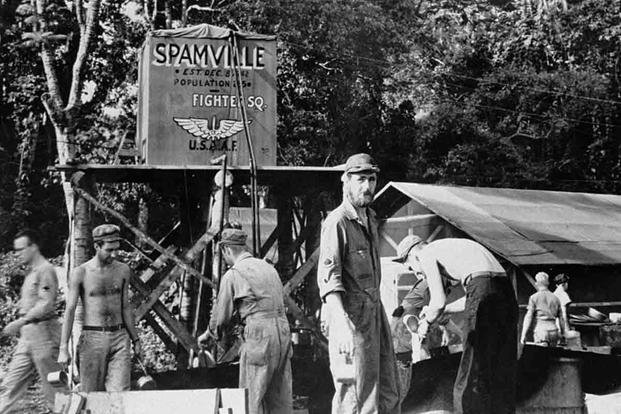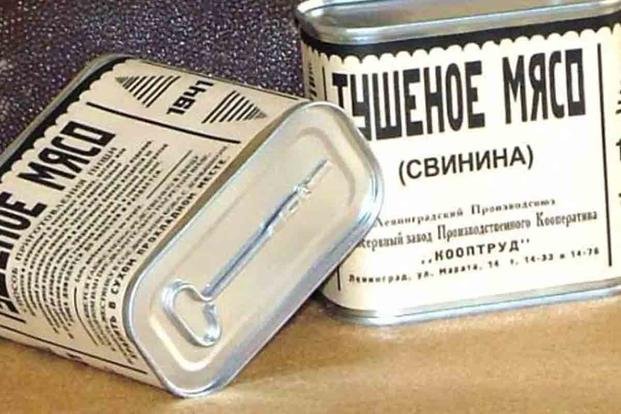Some call it SPoiled hAM; others say "Stuff, Pork and hAM." A personal favorite is "Scientifically Processed Animal Matter." Call it what you want, Spam has remained largely unchanged since it was first introduced to deli counters in 1937, and only exploded in popularity over the following 85 years.
Spam sells for a reason.
Homemakers may have been put off by the idea of unrefrigerated meat, but the need for shelf-stable foodstuffs during World War II led to a worldwide embrace of the nitrate-rich pork product. Some American troops, however, were less than thrilled with their rations of "SPecial Army Meat" and wrote letters to Jay Hormel to let him know.
Jay Hormel was the son of the company's founder, George Hormel, and a World War I veteran. After the war, Jay learned the process of canning entire hams and selling them directly to the consumer from German meatpackers. He brought the knowledge back to the U.S., and in 1927, he launched the first canned ham product in America.
The Germans might have given away the secret recipe for winning World War II right then and there.
When the senior Hormel retired and young Jay took over the company in 1929, Hormel began cranking out canned products like soups and stews. Eight years after taking over from his father, Hormel introduced a mashed, canned meat called "spiced ham," despite containing neither spice nor ham.

When the United States entered World War II in 1941, canned meats became a staple of the Allied diet. It wasn't just Spam. Canned goods of all kinds and brands were sent abroad, but the United States (for better or worse) included Spam in all its aid packages, sending 150 million pounds of "Something Posing As Meat" to England, the Soviet Union, Hawaii, Guam, Okinawa and beyond.
American troops have always been very vocal about their chow. It's one of the few unofficial God-given rights GIs have -- and exercise frequently. Three square meals a day, after all, is the one thing we all have in common, and some chow-hall staples still live in infamy. Spam is one of those staples.
Read: 6 Bygone Chow Hall Classics That Helped Shape the US Military
Spam was so easy to make, pack and ship that a lot of servicemen ended up eating it for three meals a day. No matter how good something is, it gets old after a while, and the backlash against what troops called "meatloaf without basic training" started right away.

In a 1945 interview with the New Yorker, Jay Hormel described the unexpected reaction from American soldiers, sailors, airmen and Marines. He told the magazine that he kept a "scurrilous file" of abusive letters sent to him by troops fighting the war, and was tired of being identified as the man responsible for Spam.
"The language people use!" he said, adding that he'd been compared to Hitler and Hirohito. "It's alright... damn it, we eat it in our own home!"
Hormel said he'd heard every gag about the product worth hearing, along with thousands not worth repeating, with "the air of a man who knew he is certain to hear a good many thousands more." But not everyone loathed the "ham that failed its physical."
Spam remained a mainstay of postwar menus in Allied countries, even in the Soviet Union, where it was dubbed "Roosevelt Sausage." Nikita Khrushchev, a World War II Red Army officer and later the leader of the USSR, wrote in his autobiography, "Without Spam, we wouldn't have been able to feed our army."

Margaret Thatcher, who was 20 years old at the end of World War II, remembered it fondly. After becoming the UK's prime minister, she called Spam a wartime "delicacy."
The enduring culinary legacy of Spam is its status as a staple of Asian-Pacific cuisine, especially in places with a large American troop presence, like Okinawa, the Philippines and Hawaii. Spam replaced the proteins in traditional dishes like Okinawan kimbap and Filipino Spamsilog. Even today, Spam Musubi is a go-to quick meal for Hawaiians.
During the Korean War, when American troops returned to the Korean Peninsula to keep the South out of Communist hands, Spam came along with them. U.S. and South Korean soldiers used Spam in budae jjigae, literally "Army Stew," a kind of hobo chili incorporating whatever ingredients were available. Today, South Korea is the world's second-largest consumer of Spam.
Where Spam goes, freedom and democracy seem to follow, but that doesn't mean U.S. troops were loving every minute of it. Maybe Hormel's most hurtful letter came from the Supreme Allied Commander himself, Dwight D. Eisenhower, who wrote:
"During World War II, of course, I ate my share of Spam along with millions of other soldiers. I'll even confess to a few unkind remarks about it -- uttered during the strain of battle, you understand. But as former Commander-in-Chief, I believe I can still officially forgive you your only sin: sending us so much of it."
-- Blake Stilwell can be reached at blake.stilwell@military.com. He can also be found on Twitter @blakestilwell or on Facebook.
Want to Learn More About Military Life?
Whether you're thinking of joining the military, looking for post-military careers or keeping up with military life and benefits, Military.com has you covered. Subscribe to Military.com to have military news, updates and resources delivered directly to your inbox.















